4-Day Weekend in the French Riviera: Rock Climbs, Cool Drives, and Underwater Art Trails
The south of France—and, specifically, the Mediterranean coast—is one of the world’s most coveted vacation spots. English speakers know this area as the French Riviera. The French call it Côte d’Azur, a name derived from the distinct color of the Mediterranean Sea.
While parts of this region have shifted from Italy to France over the centuries (and a small section is under the rulership of the Principality of Monaco), the coastline has been inhabited for thousands of years. The geography is spectacular—a stunning stretch of shore where the rocky foothills of the Alps drop straight into the sea. There are rugged cliffs, sandy bays, and impossibly narrow inlets, all accessed by steep switchbacked roads that seem to be suspended above the sea. The climate is temperate. The food is divine. There's every bit as much to love about the area these days as when early tourists (mainly 17th-century British aristocrats) flocked here for its healthy atmosphere and lifestyle.
Related: 4-Day Weekend in the Italian Riviera
Côte d’Azur has a well-deserved reputation for luxury—Cannes, Saint-Tropez, and Monaco especially, with their yachting set and upscale hotels and restaurants—but that doesn’t mean the entire area is expensive. Dozens of off-the-beaten-track villages and sublime beaches are tucked into the jagged coastline, furnished with quality hotels, excellent restaurants, and outdoor gear rentals that remain a bargain compared to U.S. rates. Here’s how to have a phenomenal, adventurous four-day weekend on the famous French Riviera without breaking the bank.
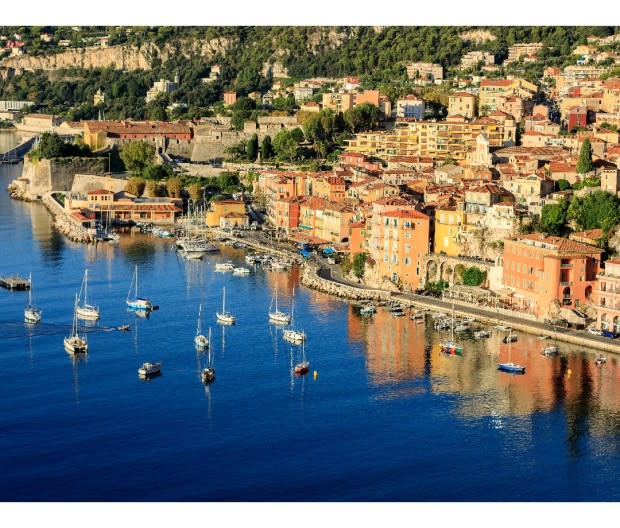
CamilleMOIRENC7
Where Is the French Riviera?
The French Riviera—aka Côte d’Azur—stretches from its western point in Toulon (some say St. Tropez) along the Mediterranean coastline of southeastern France to Menton at the Italian border. Hemmed between mountains and sea, its officially part of the Provence-Alpes-Côte d’Azur region. Lined with palms, pines, and the Mediterranean’s ubiquitously fragrant and floral maquis, the winding coastline stretches for miles across sunny beaches, picturesque promontories, charming towns, and famed French cities.
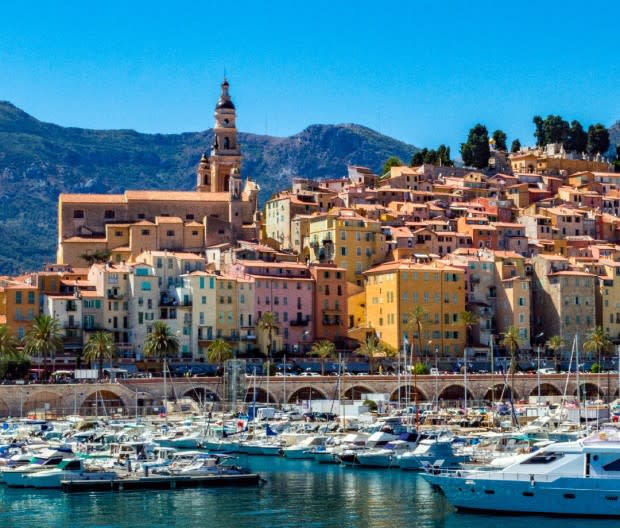
Alf/Getty
Best Time to Visit the French Riviera
Depending on what you’re looking for, Côte d’Azur is a wonderful place to visit year-round. Tourism, temperatures, and prices spike during the area’s high season throughout the summer. The weather is milder and crowds are thinner during the pleasant spring, with some sizeable tourist swings around happenings like the Cannes Film Festival and Monaco’s Grand Prix. Crowds also disperse by mid-September during the cooler autumn season, the rainiest time of year here. Winter temperatures hang in the 50s and low 60s when prices drop and the area feels wonderfully quiet between the busy Christmas holidays and Carnaval de Nice (February).
How to Get to the French Riviera
The closest and most central airport is in Nice. United Airlines offers direct flights from Newark from May through September, and Delta flies direct from New York’s JFK between March and October. You can also fly into Lyon, France, or Turin, Italy, then take a train (about five to seven hours respectively). France and most of the EU (and UK) are well-served with trains and local busses, and the entire coastline is connected with local bus service. Uber is also available in most of the larger towns.
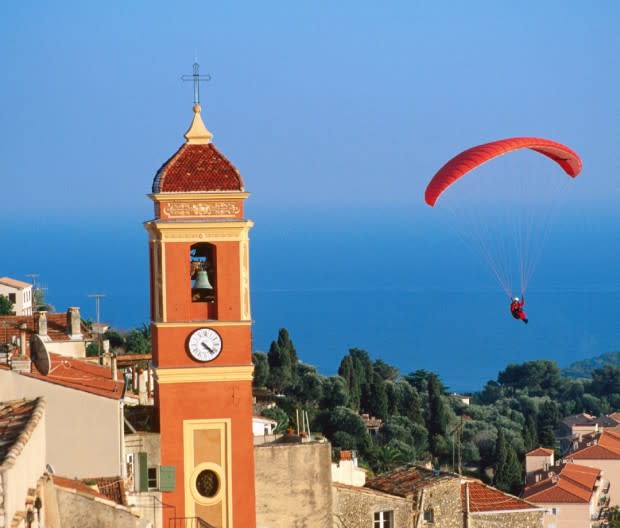
David Tomlinson
What to Do in the French Riviera
In addition to just sitting at a café or beach chair and taking in the fresh sea air, magnificent views, and relaxed vibe, there’s plenty to do in the area. You can visit Roman ruins and medieval villages or explore some of the area’s several protected nature parks—both on land and sea. There’s world-class mountain biking, hiking, paragliding, caving, canyoneering, climbing, snorkeling, surfing, and swimming here—plus enough restaurants, bakeries, wineries, and cheese shops to keep you sated alongside your daily adventures.
In Côte d’Azur, you’ll experience what the French call joie-de-vivre—a state of unadulterated joy that French locals have not only perfected but are happy to share with guests.
Whether you’re driving, café lounging, or exploring the countryside of Côte d’Azur on foot or bicycle, an exotic blend of sport, food, scenery and ideal climate greets you constantly, adding a certain zest to life. Check out more than 300 fun sports and sight-seeing opportunities here—and read on for our four-day weekend guide to the French Riviera.
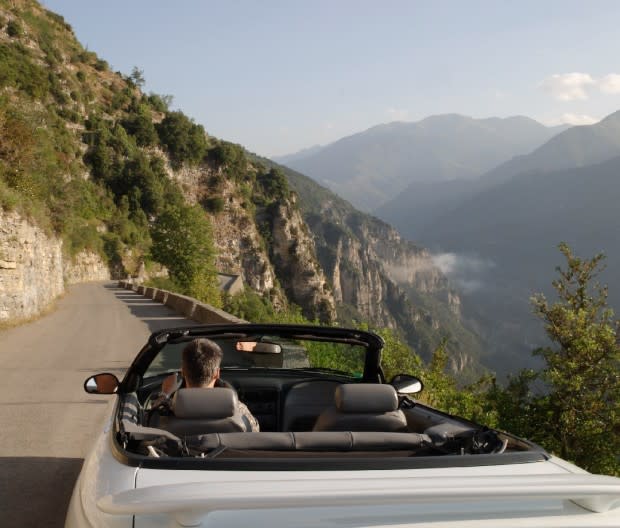
Stephan Hoerold
Day 1: Drive Grand Corniche From Nice Into the Hills
One of the three main “cliff” roads in Côte d’Azur, Grande Corniche is a spectacular stretch of road you’ve likely experienced vicariously in dozens of classic films—e.g. 1955’s Hitchcock favorite To Catch a Thief and the 1995 James Bond film Golden Eye. Built by Napoleon I and following an ancient Roman road that was known as Via Julia Augusta, the road traverses cliff bands that rise 500 meters above the sea—with vistas that are that much more dramatic in person than on a screen.
For the true Riviera experience, consider renting a sports car. Nice-based Rent A Classic Car specializes in the premium rental car experience. For about $500 a day, you can get the keys to anything from a Lotus Super Seven, AC Cobra, Ferrari 308 GTS, or Ford Mustang to a Porsche 356 Speedster, Jaguar E-Type, Mercedes 190 SL, or Austin-Healey. There’s little in this world as fun as mashing the pedal on the straightaways, then downshifting to take in the sweeping curves and hairpin corners that characterize this stretch of the Mediterranean coast. Rent a Classic Car will deliver your ride to the airport or directly to your hotel, although car buffs will want to visit the company’s headquarters and check out their museum-caliber collection of vehicles.
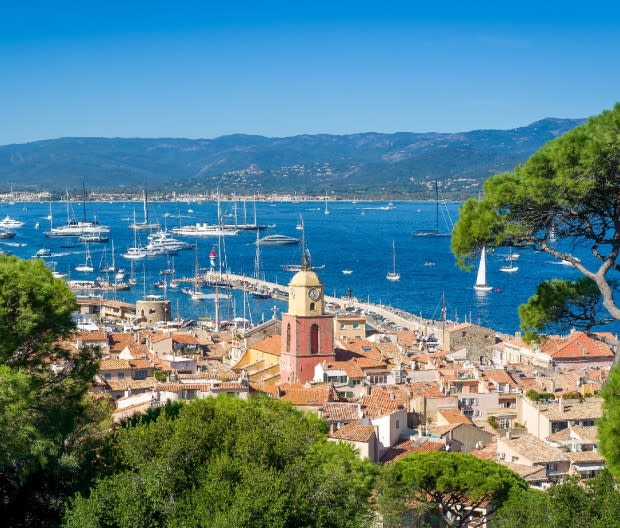
Alexander Nikiforov
No matter what horsepower you have under the hood, the views are incredible—straddling the Mercantour (or Maritime Alps) on one side and the azure Mediterranean on the other. Plenty of pullouts allow you to stretch your legs and take in the gorgeous views from San Remo to Saint-Tropez. Plan to stop in some of the medieval villages along the way. Highlights include Eze, La Turbie with its spectacular Roman-era Trophée d’Auguste, and Roquebrune Cap Martin, where a 1,000-year-old castle and 2,000-plus-year-old olive tree (possibly France's oldest tree) greets guests.
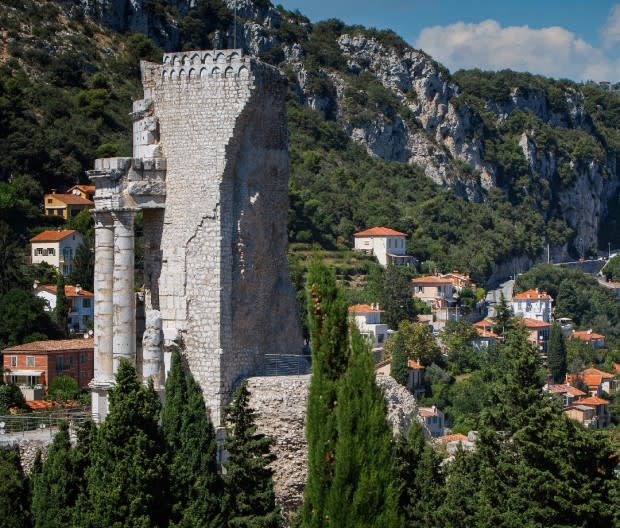
Daniel Gaug
After touring the Grand Corniche (or any of the region’s classic drives) head to Monaco to check out the Grand Prix route, or north to Grasse to smell-test its abundant perfumes. In the evening, you can cruise along the Promenade des Anglais in Nice or Croissette in Cannes to show off your ride.
Stay just northeast of Nice along the coast at Plage Baia Bella—home to France's first carbon-neutral beach—in Beaulieu-sur-Mer. Owner Agathe Vanini created this paradise on the sublime Petite Afrique beach, complete with eco-friendly initiatives that include solar panels for water heating, European-made wooden furniture, returnable glassware, and plant watering using recycled shower water, with most of the cooking done over charcoal.
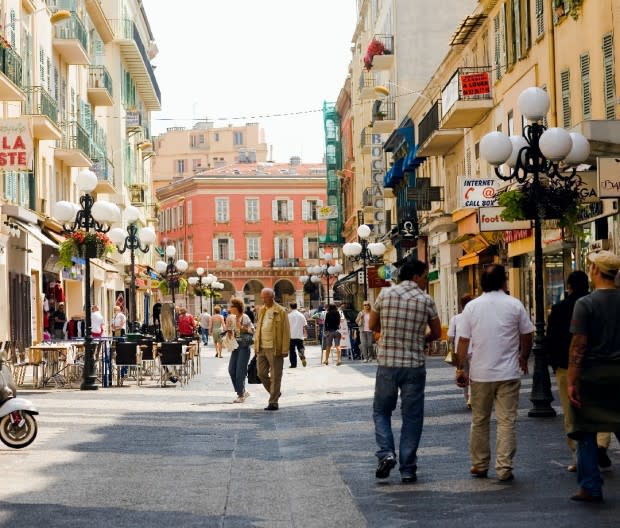
Glowimages
Day 2: Explore Nice
Côte d’Azur’s largest city, Nice is very much worth exploring. Its history alone could occupy visitors for days, with its archeological site dating some 380,000 years, Greek settlements from 350 BC, and the city’s unmissable Old Town (Vielle Ville). Stroll the famous Promenade des Anglais paralleling the Mediterranean, lined with boutique hotels, top restaurants, and long expanses of flat-pebbled beach.
One of the best ways to explore the coastline is to rent a paddle board. From the main beach of the Promenade, paddle east toward Castel Beach to cliffs where you can dock your board, scramble up the rocks, and leap into the sea. Then head to Vieux Nice for a salad Niçoise and vin. Nice is a great walking city, with dozens of private and public beaches and a vast stretch of boardwalks, urban parks, and cobble stone streets.
Related: Italy’s Amalfi Coast: 4-Day Weekend Travel Guide
Cover more miles by renting an e-bike and make sure you stop at Colline du Chateau (Castle Hill) and the traditional flower market (Marche aux Fleurs at Course Saleya) along the way. Then, head over to the Port district to ogle those super yachts and, of course, swing past the French Foreign Legion Office (even if you’re not signing up today).
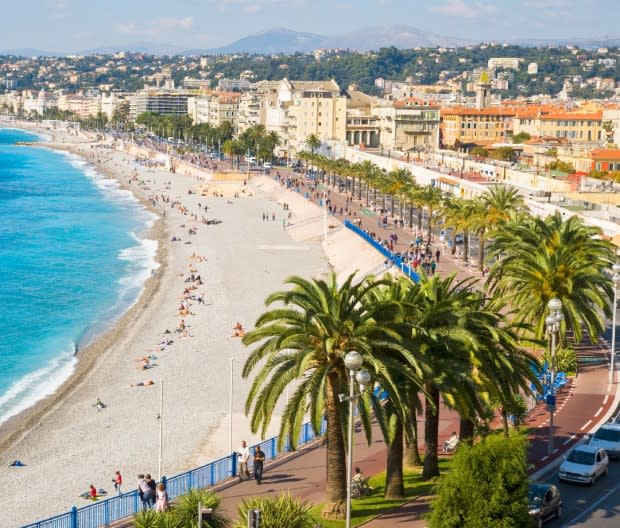
John Harper
Stay at the 5-star Victoria-Maison Albar, just 300 yards from the Promenade des Anglais, appointed with 132 rooms and suites imagined by the dynamic duo of architects Marc Hertrich and Nicolas Adnet (Studio MHNA) that overlook the Bay of Angels and mountains of Nice hinterland. Behind the preserved facade of the ancient Park Hôtel, the site also has a huge spa, rooftop restaurant, bar, and pool facing the sea. The ground floor houses a dozen luxury boutiques set along the Park Avenue Nice gallery, opening late 2023.
Day 3: Rock Climb in Saint-Jeannet
The limestone cliffs along Côte d’Azure are spectacular to look at and magnificent to climb. It’s no wonder why France is often referred to as the birthplace of sport climbing. In some places along the Mediterranean coastline, you can reach climbs by boats, such as the rocky cliffs of Calanques near Marseilles (not officially part of the French Riviera, but well worth a visit). Not only is the rock in southern France generally very good for climbing, but limestone lends itself to the sport with abundant holds for the hands and feet. Due to sunny weather, mild temperatures, and walls with a variety of exposures that get varying degrees of sun and shade, you can climb year-round here and choose between an assortment of scrambles, sport climbs, traditional climbs, and via ferratas.
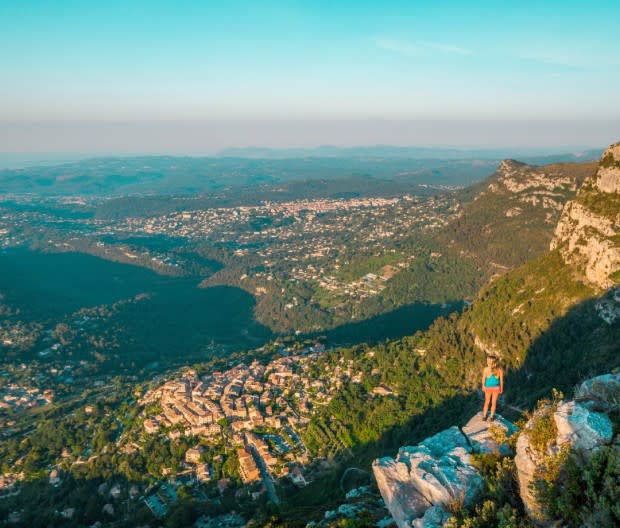
CRT Côte d'Azur, France/Isabelle FAB
While there are a handful of established climbing areas, including La Turbie near Monaco and Gorges du Loup southwest of Nice, the best day is spent in Saint-Jeannet, a hill-top village with narrow cobblestone streets dating back to medieval times. Just 30 miles inland from Nice, Saint-Jeannet has more than 460 climbing routes covering the Baou, a provincial word meaning “steep rock.” The cliffs rise up hundreds of meters above the village, with a trail extending from town. For first half-mile, you’ll follow narrow cobblestone paths before ascending a well-kept dirt trail with lots of switchbacking and scrambling. You can walk to the top of the cliffs in about 90 minutes each way.
From the cliffs, you can see the Mediterranean, the Esterel mountains, the Alps, and the island of Corsica on a clear day. Although there’s some trad climbing, most of the routes are pre-protected with bolts. There’s been a big emphasis on safety with the local Nice Cote d’Azur council working with climbers to place nearly 2,000 bolts (and anchors) to support climbing and protect the rock from erosion. You can climb or hike year-round and hire a solid guide at the mountain shop in the village.
Related: 4-Day Weekend Travel Guide to Marseille, France
After climbing, eat at Maï Pizza in the old town of Saint-Jeannette, and check into the Avocado Hotel—a boutique property just a few minutes drive down the hill from the old village. The surprisingly affordable hotel has beautiful gardens and outdoor patios, an excellent restaurant and bar that specializes in rum cocktails, and cozy rooms with sweet views of the surrounding hills and rocks. Check the website for live music. Across the street is a great bakery (Moulin de Floor) where you can pick up snacks for a day of hiking and climbing.
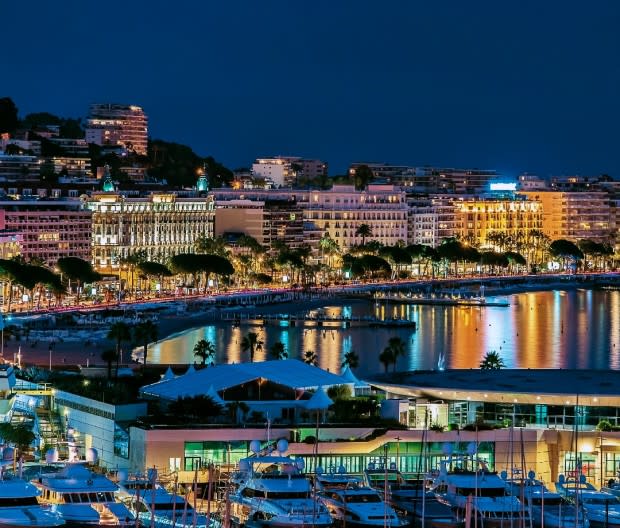
StockByM
Day 4: Surf and Snorkel the Beaches of Cannes
Not surprisingly, Côte d’Azur offers an abundance of watersports with plenty of rental shops to equip you with whatever you need for a fun day on the water. You can hop on a day cruise, rent a boat or paddleboard, snorkel, and catch some quality waves in Cannes— recognized as a “Ville de Surf” city by the French Surfing Federation. Island hoppers can head offshore to Île Sainte-Marguerite and the Lérins Islands, just off the Cannes coast.
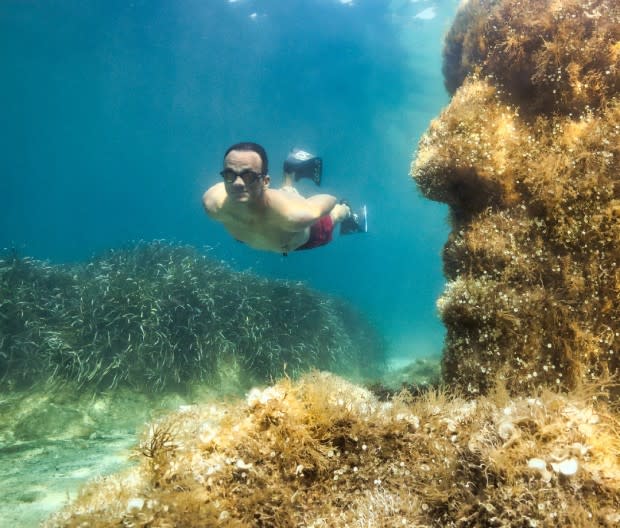
Palais des Festivals/Maxime Tancons
Another not-to-be-missed adventure is snorkeling along the underwater discovery trail at Pointe de l’Aiguille about a half hour south of Cannes. The 600-foot swim trail consists of four white buoys that make different underwater environments—the Posidonia Meadows, Rocky Screes, Vertical Walls, and the Pinnacle. Then head to the Underwater Eco-Museum, the first eco-museum in France and the Mediterranean that can be visited while snorkeling. Bring your snorkel, mask, and fins, as you’ll be able to dive down to see six monumental statues by renowned artist Jason deCaires Taylor.
Several quality hotels in Cannes cover all price ranges. The Hôtel Splendid is a top choice as the building is gorgeous, the rooms are well-lit with sublime balcony views overlooking the harbor. Cap off your four perfect days along the French Riviera with an afternoon Kir royale, a classic French cocktail made with Champagne and creme de cassis.
